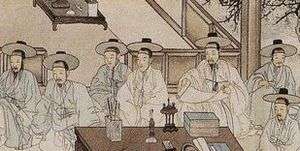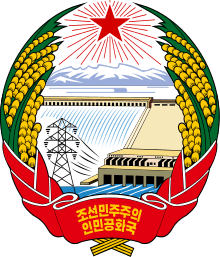National symbols of North Korea
 |
| Part of a series on the |
| Culture of Korea |
|---|
| History |
|
Music and performing arts |
|
|
Monuments |
|
National symbols of Korea |
|
Upon its liberation in 1945 and subsequent foundation in 1948, North Korea adopted national symbols distinct from the national symbols of South Korea. The traditional flag of Korea, the Taegukgi, and the symbol Taeguk, were swapped for communist symbols.
Some of the symbols of North Korea – the national emblem, flag, anthem and capital – are defined in the constitution of North Korea, while others such, as the national sport Ssirŭm or the national dish kimchi, are traditional. Some traditional symbols are shared with the South but with different connotations. Mount Paektu, for instance, is recognized as the symbol of Korea across the peninsula, but North Koreans revere it as the birthplace of Kim Jong-il. Some North Korean symbols are complemented with symbols for the Kim family. For example, the Magnolia sieboldii is the national flower but the hybrid orchids Kimilsungia and Kimjongilia are also respected.
Constitutionally defined symbols
Chapter VII of the Socialist Constitution of the Democratic People's Republic of Korea defines the emblem, flag, anthem and capital of North Korea.
National emblem

The national emblem of the Democratic People's Republic of Korea bears the design of a grand hydroelectric power station under Mt. Paektu, the sacred mountain of the revolution, and the beaming light of a five-pointed red star, with ears of rice forming an oval frame, bound with a red ribbon bearing the inscription "The Democratic People’s Republic of Korea."
Article 169 of the Socialist Constitution of the Democratic People's Republic of Korea (1972, amended 2013)[1]
The present emblem of North Korea was adopted on 9 September 1948, on the day of the founding of the republic. It features a hydroelectric plant and the design was,[2] much like the flag,[3] probably commissioned by the Soviets. The design was amended in 1993 to feature, under the red star, Mount Paektu – itself an important symbol of Korea[2] – which North Korea considers the birthplace of Kim Jong-il. [4]
National flag

The national flag of the Democratic People's Republic of Korea consists of a central red panel, bordered both above and below by a narrow white stripe and a broad blue stripe. The central red panel bears a five-pointed red star within a white circle near the hoist.
The ratio of the width to the length is 1:2.
Article 170 of the Socialist Constitution of the Democratic People's Republic of Korea (1972, amended 2013)[1]
The flag of North Korea was designed in 1948 and adopted the same year to replace Taegukgi, the traditional flag. The Taeguk symbol that now remained in the flag and emblem of the South was subsequently removed from North Korean photos and texts.[3] The colors of the North Korean flag – red, white and blue – are considered national colors and symbolize respectively: revolutionary traditions; purity, strength, and dignity; and sovereignty, peace, and friendship.[5]
National anthem
The national anthem of the Democratic People's Republic of Korea is "The Patriotic Song."
Article 171 of the Socialist Constitution of the Democratic People's Republic of Korea (1972, amended 2013)[1]
The national anthem is "Aegukka" (Korean for The patriotic song), written by Pak Se-yong and composed by Kim Won-gyun in 1946. Musically, it is similar to South Korea's national anthem, spelled "Aegukga".[6] In addition to "Aegukka", the "Song of General Kim Il-sung and "Song of General Kim Jong-il" play an equally important role.[7] The folk song "Arirang" is known as the "unofficial national anthem of Korea".[8] North and South Korea have submitted it separately to UNESCO's Representative List of the Intangible Cultural Heritage of Humanity.[8]
Capital
The capital of the Democratic People's Republic of Korea is Pyongyang.
Article 172 of the Socialist Constitution of the Democratic People's Republic of Korea (1972, amended 2013)[1]
The first 1948 constitution defined Seoul – the present capital of South Korea – as the capital city. In order to have succeeded in realizing this, the South Korean regime would have had to be removed.[9] In 1972 the constitution was revised and Pyongyang designated as the capital.[10]
Animals and plants
.jpg)
North Korea has no official national animal, but the mythological winged horse Chollima is taken to be a national symbol.[11] North Korean Siberian Tigers are considered unofficial symbol of both Koreas as it represent the Korean people and nation.[12]
The national dog is the Pungsan dog. Pungsan is named after what was once Phungsan County (now Kimhyonggwon County) in Ryanggang Province. It has been bread as a hunting dog. Recently, efforts to conserve and proliferate the breed have been taken.[13]
The national bird is the northern goshawk (Accipiter gentilis).[14] The bird inhabits the northern and central parts of the peninsula and sometimes migrates to the southern part of the country in winter. Historically, Koreans have used the goshawk to hunt pheasants, pigeons and hares.[15]
The national flower is the Magnolia sieboldii.[16] It was originally called "hambak" in Korean but was renamed "mokran" after the suffix "-ran" given to beautiful flowers in Korean. The act of renaming is attributed to Kim Il-sung.[17] Two orchid hybrids are also significant: Kimilsungia and Kimjongilia.[18] They are both considered unofficial national flowers.[19]
The national tree is pine (Pinaceae).[20][21] Pines are considered beautiful aspect of scenery and have been featured in Korean visual arts since ancient times.[22] Pine trees are associated with Kim Il-sung's guerilla activities in the forests around Mount Paektu, and thus with the founding of the country.[23] Earlier, Kim Hyong-jik, the father of Kim Il-sung, had composed a poem: "Green Pine on Nam Hill" to promote liberation of the country.[22]
Others
The national day on 9 September is the Foundation Day, a public holiday that commemorates the date when Kim Il-sung appointed a cabinet in 1948.[24] Both the birthplace of Kim Il-sung at Mangyongdae and the Juche Tower are considered national monuments.[25][26]
The national dish is kimchi, a spicy, fermented vegetable dish.[27] North Korean kimchi tends to be less spicy than its Southern counterpart.[28] Both are inscribed on UNESCO's Representative List of the Intangible Cultural Heritage of Humanity.[29] The traditional Chosŏn-ot (hanbok) is the national dress.[30] The national sport is Ssirŭm, traditional Korean wrestling, but the martial art Taekwondo is important, too.[31]
Kim Il-sung, founder and president of the modern North Korean state and his successor Kim Jong-il are considered national heroes if not personifications.[32]
Mount Paektu is recognized as a symbol of Korea in the North and South alike, but North Korea has attached special significance to it by claiming that it is the birthplace of Kim Jong-il. Tangun, who is considered the founder-king of the Korean nation, is also said to be born at Mount Paektu and is celebrated in North Korea especially. In 1993 North Korean archaeologists located and dated remains in a tomb that they declared Tangun's grave.[4]
See also
- Culture of North Korea
- Cultural assets and National Treasures of North Korea
- Names of North Korea
- Natural monuments of North Korea
- Orders and medals of North Korea
- List of things named after Kim Il-sung
References
- 1 2 3 4 Socialist Constitution of the Democratic People's Republic of Korea (PDF). Pyongyang: Foreign Languages Publishing House. 2014. p. 35. ISBN 978-9946-0-1099-1 Amended and supplemented on April 1, Juche 102 (2013), at the Seventh Session of the Twelfth Supreme People's Assembly.
- 1 2 Tertitskiy, Fyodor (23 September 2014). "The Evolution of North Korea's Coat of Arms". Daily NK. Retrieved 30 September 2015.
- 1 2 Tertitskiy, Fyodor (20 June 2014). "Kim Tu Bong and the Flag of Great Extremes". Daily NK. Retrieved 30 September 2015.
- 1 2 Pratt, Keith (2007). Everlasting Flower: A History of Korea. London: Reaktion Books. p. 33. ISBN 978-1-86189-335-2.
- ↑ "The World Factbook". cia.gov. Retrieved 22 September 2015.
- ↑ Hoare, James E. (13 July 2012). Historical Dictionary of Democratic People's Republic of Korea. Plymouth: Scarecrow Press. p. 273. ISBN 978-0-8108-7987-4.
- ↑ Lankov, Andrei (24 April 2007). North of the DMZ: Essays on Daily Life in North Korea. McFarland. p. 38. ISBN 978-0-7864-5141-8. Retrieved 25 April 2015.
- 1 2 "N. Korea's Arirang wins UNESCO intangible heritage status". Yonhap. 27 November 2014. Retrieved 25 November 2015.
- ↑ Eberstadt 1999, p. 26.
- ↑ Eberstadt 1999, p. 32.
- ↑ Foran 2013, p. 132.
- ↑ 호랑이 [Horang-i (Tiger)] (in Korean). Encyclopedia of Korean Culture. Retrieved 8 January 2010.
- ↑ Kang Su-jong (2015). "Symbols of Korea" (PDF). Korea Pictorial (4): 25.
- ↑ "Protection of Goshawk Active in DPRK". Naenara. KCNA. 5 March 2016. Retrieved 6 March 2016.
- ↑ "Goshawk, National Bird of Korea". kcnawatch.nknews.org. Korean Central News Agency. 21 April 2014. Retrieved 22 September 2015.
- ↑ Lim, Reuben C. J. (29 June 2013). "Floral Emblems of the world". anbg.gov.au. Australian National Herbarium. Retrieved 9 September 2016.
- ↑ "National Flower of the DPRK". Naenara. Retrieved 19 November 2015.
- ↑ Foran 2013, p. 38.
- ↑ Minahan 2010, p. 82.
- ↑ "North Korea Newsletter 360 (April 30, 2015)". Yonhap News Agency. 30 April 2015. Retrieved 22 September 2015.
- ↑ Han Su-yong (2016). Understanding Korea 3: Politics (PDF). Pyongyang: Foreign Languages Publishing House. ISBN 978-9946-0-1406-7.
- 1 2 "Pine Tree Symbolic of Spirit of DPRK". web.archive.org. KCNA. 24 April 2015. Archived from the original on 7 July 2015. Retrieved 22 September 2015.
- ↑ Zhiqun Zhu, ed. (2012). New Dynamics in East Asian Politics: Security, Political Economy, and Society. New York/London: Continuum. p. 265. ISBN 978-1-4411-6621-0.
- ↑ Tertitskiy, Fyodor (9 September 2015). "The Soviet strategy behind NK's Foundation Day". Daily NK. Retrieved 30 September 2015.
- ↑ Cornell, Erik (2005). North Korea Under Communism: Report of an Envoy to Paradise. Translated by Rodney Bradbury. London: Routledge. p. 123. ISBN 978-1-135-78822-3.
- ↑ Lerner, Mitchell (2008). "Making Sense of the 'Hermit Kingdom': North Korea in the Nuclear Age". Origins. 2 (3). Retrieved 5 October 2015.
- ↑ Becker, Jasper (2005). Rogue Regime : Kim Jong Il and the Looming Threat of North Korea: Kim Jong Il and the Looming Threat of North Korea. USA: Oxford University Press. p. 121. ISBN 978-0-19-803810-8.
- ↑ "North Koreans Want UNESCO Recognition for Their Kimchi Variation". YouTube. 1:10: Voice of America. 2 December 2015. Retrieved 3 December 2015.
- ↑ "UNESCO Adds N. Korea's Kimchi-Making to Cultural Heritage List". KBS. 3 December 2015. Retrieved 3 December 2015.
- ↑ French, Paul (2007). North Korea: The Paranoid Peninsula: A Modern History, Second Edition (2 ed.). London / New York: Zed Books. p. 42. ISBN 978-1-84277-905-7.
- ↑ Behnke, Alison (2005). North Korea in Pictures. Twenty-First Century Books. p. 117. ISBN 978-0-8225-1908-9.
- ↑ Minahan 2010, p. 84.
Works cited
- Eberstadt, Nick (1999). The End of North Korea. Washington: American Enterprise Institute. ISBN 978-0-8447-4087-4.
- Foran, Racquel (2013). North Korea. Minneapolis: ABDO Publishing Company. ISBN 978-1-61480-875-6.
- Minahan, James (2010). The Complete Guide to National Symbols and Emblems. 1. Satna Barbara: ABC-CLIO. ISBN 978-0-313-34497-8.
Further reading
| Wikimedia Commons has media related to Symbols of North Korea. |
- Hong Kyong-sik (1992). Magnolia Sieboldii : Korea's National Flower (PDF). Pyongyang: Foreign Languages Publishing House. OCLC 52473426.
- So Yong-il (2010). Ri Sun-yong, ed. Kimchi : Korean Speciality (PDF). Pyongyang: Foreign Languages Publishing House. ISBN 978-9946-0-0521-8.
- Tangun : Founder-King of Korea : Collection of Treatises (PDF). Translated by An Jong-ho, Choe Ki-ju, Ryom Chol-su, O Su-gun and Ryang Sun-chol. Pyongyang: Foreign Languages Publishing House. 1994. OCLC 272459364.
